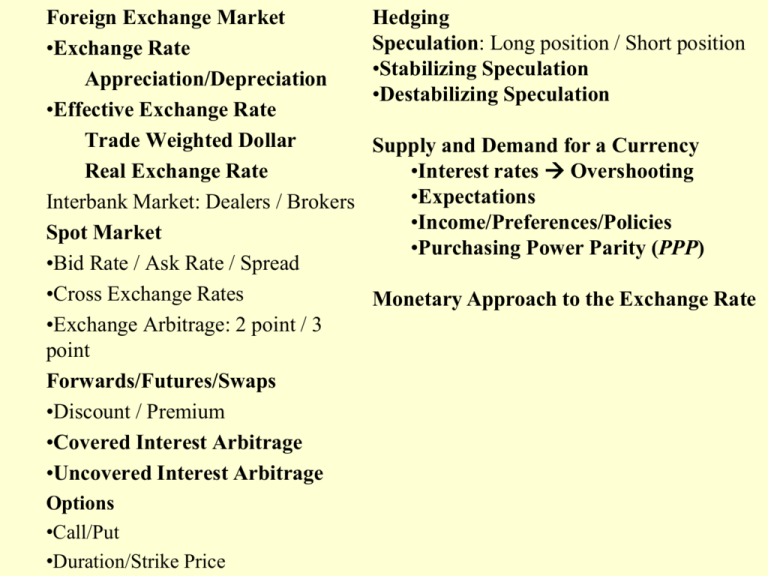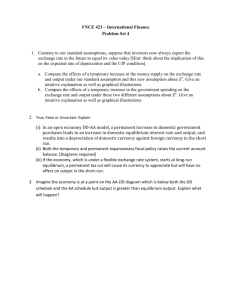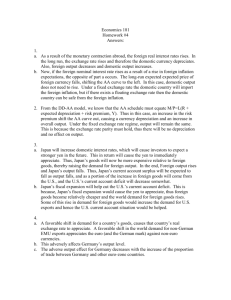
Foreign Exchange Market
•Exchange Rate
Appreciation/Depreciation
•Effective Exchange Rate
Trade Weighted Dollar
Real Exchange Rate
Interbank Market: Dealers / Brokers
Spot Market
•Bid Rate / Ask Rate / Spread
•Cross Exchange Rates
•Exchange Arbitrage: 2 point / 3
point
Forwards/Futures/Swaps
•Discount / Premium
•Covered Interest Arbitrage
•Uncovered Interest Arbitrage
Options
•Call/Put
•Duration/Strike Price
Hedging
Speculation: Long position / Short position
•Stabilizing Speculation
•Destabilizing Speculation
Supply and Demand for a Currency
•Interest rates Overshooting
•Expectations
•Income/Preferences/Policies
•Purchasing Power Parity (PPP)
Monetary Approach to the Exchange Rate
Flavors of exchange rates and contracts
• Spot rates: for currency exchanges “on the spot”
• Forward rates: for currency exchanges that will occur at a future
(“forward”) date.
– Forward contracts can be customized.
• Forward dates are typically 30, 90, 180, or 360 days in the future.
• Rates are negotiated between two parties in the present, but the exchange
occurs in the future.
• Foreign exchange swaps: a combination of a spot sale with a
forward repurchase.
• Futures contracts: designed by a third party for a standard amount
of foreign currency delivered/received on a standard date.
– Contracts can be bought and sold in markets
– Only the current owner is obliged to fulfill the contract.
• Options contracts: designed by a third party for a standard amount
of foreign currency delivered/received on or before a standard date.
– Pay a premium for the option, but not obligation, to buy (call option) or sell a
currency (put option) at a strike price before the option’s expiration date.
Covered Interest Arbitrage
1) purchase foreign currency at spot rate and use it to
finance purchase of foreign assets (bonds)
2) contract in the forward market to sell amount of
foreign currency that will be received
because of activity in the forward market such
investment opportunities quickly disappear
Uncovered Interest Arbitrage
o moving funds into
foreign currency to
take advantage of
higher rate of
return without
forward contract
o Extra return:
UK
U.S.
Percentage
= Interest - Interest ± Appreciation/Depreciation
Rate
Rate
of Pound
Factors influencing exchange rates:
Supply and Demand for a Currency
Short – run … financial transactions
• Market fundamentals
– Current account balances
– Real interest rates
• Market expectations
– News about future market fundamentals
– Speculative opinion about future exchange rates
Factors influencing exchange rates
Medium – run
– Real income … business cycle
– Monetary policy and fiscal policy
– Product availability
Long – run
– Inflation rates
– Consumer preferences for domestic or foreign
products
– Productivity changes affecting production costs … and
prices
– Profitability and riskiness of investments
– Government trade policy
Impact of interest rate differentials: drop in US
interest rate $ depreciation
S1
Dollars
per Yen
S0
B
.0080
.0075
A
D1
D0
30
35
40
45
50
55
Millions of Yen
60
65
70
FIGURE
12.6
Interest rate differentials and exchange rates
An increase in the U.S. real interest rate increases the expected return on dollar assets, such as Treasury bills
and certificates of deposit. This increase encourages flows of foreign investment into the United States, thus
causing the dollar’s exchange value to appreciate. Conversely, a decrease in the U.S. real interest rate reduces
the expected profitability on dollar assets, which promotes a depreciation of the dollar’s exchange value.
8
© 2011 Cengage Learning. All Rights Reserved. May not be copied, scanned, or duplicated, in whole or in part, except
Impact of expectations:
expectation of $ depreciation $ depreciation
S1
Dollars
per Pound
S0
B
1.70
1.50
A
D1
D0
60
65
70
75
80
85
90
Millions of Pounds
95
100
Overshooting Exchange Rate Volatility
From Uncovered Interest Arbitrage:
Expected depreciation of $ = ius – iuk
•From S-D analysis, if ius falls, the $ depreciates
•But why hold any $ assets if ius < iuk?
•Only if you expect $ to appreciate in the future.
•How can you expect $ to appreciate in the future when it
depreciates owing to the drop in ius?
•If $ depreciates so much when ius falls that, looking into the
future, $ can be expected to appreciate
•Immediate $ depreciation overshoots eventual depreciation.
Impact of real income differentials:
increase in US income $ depreciation
S0
Dollars
per Pound
B
1.60
1.50
A
D1
D0
0
5
10
15
20
25
Millions of Pounds
30
35
40
Impact of inflation rate differentials:
high US inflation $ depreciation
S1
Dollars
per Pound
S0
B
1.70
1.50
A
D1
D0
60
65
70
75
80
85
90
Millions of Pounds
95
100
Purchasing power parity (PPP):
The Law of One Price
• A good should cost the same in all countries (aside from
tariffs or transportation costs)
• Exchange rates should make prices equal across countries
P = ER x P*
($/bourbon) = ($/£) x (£ /scotch) = ($/scotch)
• If two countries have different inflation rates, exchange
rates will move keep prices the same
• The currency of the high inflation country will depreciate
(P/P*) ER ($/£)
Purchasing power parity: United States - United
Kingdom, 1973–2003
This figure suggests that the predictive power of the purchasing-power-parity theory is most
evident in the long term. In the short term, the theory has negligible predictive power.
15
Inflation differentials and the dollar’s exchange
value
16
Alternative approaches to exchange rates
Monetary approach
• In long run, exchange rate depends on
– Demand for money, Md = L(Y, P, i)
• Md depends on real income, prices, interest rates
– Supply of money, Ms
• Ms is controlled by central banks
• Ms $ depreciates
• Real income Md $ appreciates
• Interest rate Md $ depreciates ??!?
– Why should i rise in long-run?
• Inflation and expectations of inflation!
• It follows that $ will depreciate if i rises
Nominal and Real Exchange Rates
Real Exchange Rate Index = Nominal Index x (Our CPI/Their CPI)
If our prices are rising faster than foreign prices yet our nominal
exchange rate hasn’t depreciated, we’re really getting a better deal
The Dollar’s Exchange Rate:
The Floating Rate Era
Basket of major currencies
per dollar:
Up $ appreciation
Down $ depreciation







